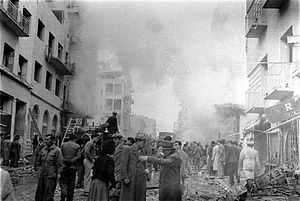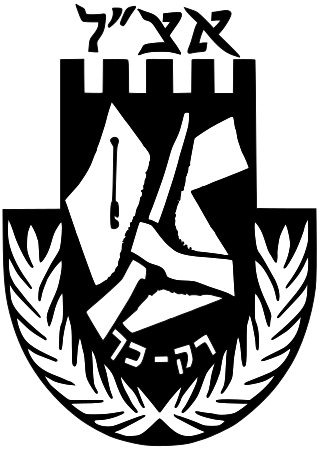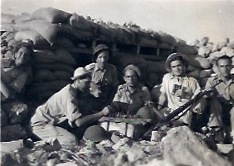
A series of attacks were perpetrated or ordered by Palestinian Arabs, some of them acting as suicide bombers, on Jewish targets in Jerusalem's Ben Yehuda Street from February 1948 onwards. Ben Yehuda Street was a major thoroughfare.

A series of attacks were perpetrated or ordered by Palestinian Arabs, some of them acting as suicide bombers, on Jewish targets in Jerusalem's Ben Yehuda Street from February 1948 onwards. Ben Yehuda Street was a major thoroughfare.
| 1948 Ben Yehuda Street bombing | |
|---|---|
| Location | Ben Yehuda Street, Jerusalem |
| Date | February 22, 1948 |
| Target | Pedestrian shopping mall |
Attack type | car bombs |
| Deaths | 58 |
| Injured | 123 |
The attacks took place during the 1947–1948 civil war in Mandatory Palestine, after the United Nations Partition Plan for Palestine in November 1947 and before the Israeli Declaration of Independence in May 1948.
On February 22, 1948, three British Army trucks led by an armoured car driven by Arab irregulars and British deserters exploded on Ben Yehuda Street killing from 49 to 58 civilians [1] [2] and injuring from 140 to 200. [3] [4] [5] [6] The bomb may have been intended to kill members of the Furmans (Palmach convoy escorts) who lodged in the Atlantic and Amdursky Hotels but had left on patrol shortly beforehand. [7] In addition to the two hotels, the Vilenchick Building and the Kupat-Milveh Bank were destroyed. [7] The bomb had been created by Fawzi al-Qutb. The convoy was led by a Jerusalemite militant, 'Azmi al-Ja'uni, who spoke fluent English and could pass himself off as a British officer. [4] Two British deserters, Eddie Brown, a police captain who claimed that the Irgun had killed his brother, and Peter Madison, an army corporal, had been persuaded to join the attack, also by the promise of substantial financial rewards. [8]
A leaflet stating that the explosion was in response to an Irgun bomb attack three days earlier, in Ramla, on 19 February, was distributed the following evening. It was signed by Abd al-Qadir, who assumed responsibility for the operation. [3] [9] Abd al-Qadir himself, in Cairo the day after, left a statement to Al-Ahram to the same effect and the Army of the Holy War High Command reiterated the declaration in Palestine. [4] Husayn al-Khalidi, secretary of the Arab Higher Committee, deplored the act as 'depravity unfit for the Arab spirit,' [4] while the Committee itself, in an attempt to distance itself from the incident, tried to throw doubt on the authenticity of Abd al-Qadir's public statements. [4]
In the ensuing confusion, Jewish residents immediately blamed the British for the attack. David Ben-Gurion, on visiting the site of the carnage, has been cited as putting some responsibility for this Arab attack on the shoulders of Jewish thugs, stating, "I could not forget that our thugs and murderers had opened the way." [10] The Irgun spread word ordering militants to shoot on sight any Englishman. [11] By day's end, eight British soldiers had been shot dead, while a ninth was murdered while laid up in a Jewish clinic for treatment of a wound. [3] Lehi also reacted several days later by blowing up a train full of British soldiers as it drew out of Rehovot station, killing 27. [3]
The day after, on 23 February, a Jewish offensive, deploying mortars, was launched against the Arab neighbourhood of Musrara, in Jerusalem, killing seven Arabs, including an entire family. The Arabs believed it was in revenge for the Ben-Yehuda Street bombing, though, according to Israeli historian Itamar Radai, at the time the Jews and their official institutions blamed only the British for the incident. [12]
| 1975 Ben Yehuda Street Bombing | |
|---|---|
| Location | Zion Square, leading onto Ben Yehuda Street, Jerusalem |
| Date | July 4, 1975 |
| Target | Pedestrian shopping mall |
Attack type | time bomb |
| Deaths | 15 |
| Injured | 77 |
| Perpetrator | Ahmed Jabara, aka Abu Sukar |
On Friday, July 4, 1975, a refrigerator that had five kilograms of explosives packed into its sides exploded on Zion Square, a main city square connecting Ben Yehuda Street and Jaffa Road. Fifteen people were killed and 77 injured in the attack. [13] Ahmad Jabara, who was responsible for placing the bomb, was arrested and sentenced to life and thirty years in prison, but was released by Israel in 2003 after serving 27 years as a gesture to Arafat, who then appointed him his adviser on prisoners affairs. [14] He died in Ramallah in 2013. [14]
On November 13, 1975, an explosive charge went off near Cafe Naveh on Jaffa Road, near the pedestrian mall. Six people were killed and 40 injured. [15]
| 1976 Ben Yehuda Street bombing | |
|---|---|
| Location | Ben Yehuda Street, Jerusalem |
| Date | May 3, 1976 |
| Target | Pedestrian shopping mall |
Attack type | Bombing |
| Deaths | 1 |
| Injured | 33 |
| Perpetrators | DFLP |
On April 9, 1976, a car bomb was dismantled on Ben Yehuda Street shortly before it was to have exploded.[ citation needed ]
On May 3, 1976, thirty-three passers-by were injured when a booby-trapped motor scooter exploded at the corner of Ben Yehuda and Ben Hillel Streets. Among those injured were the Greek consul in Jerusalem and his wife. The following day, on the eve of Independence Day, the municipality organized an event at the site of the attack, under the slogan "Nevertheless." [16] One person is also reported to have died in the attack which was perpetrated by the Democratic Front for the Liberation of Palestine (DFLP). [17]
| 1997 Ben Yehuda Street Bombing | |
|---|---|
| Location | Ben Yehuda Street, Jerusalem |
| Date | September 4, 1997 |
| Target | Pedestrian shopping mall |
Attack type | suicide bombers |
| Deaths | 5 (+ 3 suicide bombers) |
| Perpetrators | Hamas |
On September 4, 1997, three Hamas suicide bombers simultaneously blew themselves up on the pedestrian mall, killing five Israelis. The bombing was carried out by Palestinians from the village of Asira al-Shamaliya. [18]
Three 14-year-old girls were killed in the attack: Sivann Zarka, Yael Botvin and Smadar Elhanan. [19] Elhanan was the daughter of peace activist Nurit Peled-Elhanan and the granddaughter of Israeli general and politician Mattityahu Peled.[ citation needed ]
The family of Yael Botvin, a U.S. citizen, filed a lawsuit in the United States against the Islamic Republic of Iran. [20]
A default judgment of $251 million in compensatory and punitive damages was awarded to the relatives of Americans killed in the attack. There were few assets of the Iranian government in the United States following the judgment. The plaintiffs threatened to seize valuable Persian artifacts located in Chicago museums and sell them for proceeds, leading to the Chicago's Persian heritage crisis, as well as suing the account of the Bank Melli Iran in the Bank of New York, but having the United States Department of Justice speak as amicus curiae in support of Bank Melli, advising that the bank had no responsibility for turning the funds over, resulted in a ruling against the students. [21]
| 2001 Ben Yehuda Street Bombings | |
|---|---|
| Part of Second Intifada | |
| Location | Ben Yehuda Street, Jerusalem |
| Date | December 1, 2001 |
| Target | Pedestrian shopping mall, responding paramedics |
Attack type | suicide bombers and a car bomb |
| Deaths | 11 (+ 2 suicide bombers) |
| Injured | 188 |
| Perpetrators | Hamas |
On December 1, 2001, two suicide bombers detonated themselves on Ben Yehuda Street, followed by a car bomb set to go off as paramedics arrived. [22] [ dubious ] The suicide bombers killed eleven victims aged 15 to 21, [23] including a number of soldiers out of uniform,[ citation needed ][ dubious ] and 188 were injured. Hamas claimed responsibility, [23] stating that it was in retaliation for the killing of senior Hamas militant Mahmud Abu Hanoud. A Hamas spokesman in Gaza stated that these bombings did not assuage its lust for vengeance and that it would carry out further bombings. [24] [25] Lawsuits were filed against Arab Bank, NatWest and Crédit Lyonnais alleging that they channelled money to Hamas. [26]

The Irgun, or Etzel, was a Zionist paramilitary organization that operated in Mandatory Palestine between 1931 and 1948. It was an offshoot of the older and larger Jewish paramilitary organization Haganah. The Irgun has been viewed as a terrorist organization or organization which carried out terrorist acts.

Zionist political violence refers to politically motivated violence or terrorism perpetrated by Zionists. The term is used to describe violence committed by those who support the political movement of Zionism, and violence committed against opponents of Zionism. The violence often takes the form of terrorist attacks and has been directed against both Jewish and Arab targets. The most active period of most notable Zionist political violence began on June 30, 1924, through the 1940s, and continues to the present day, usually for the purpose of expanding Zionist settlements in Palestine.
Note: This compilation includes only those attacks that resulted in casualties. Attacks which did not kill or wound are not included.
Note: The death toll quoted here is just the sum of the listings. There may be many omissions from the list. The human rights organisation B'Tselem has complied statistics of about 600 deaths during 2003 in the occupied territories alone.

Killings and massacres during the 1948 Palestine war resulted in the deaths of hundreds of civilians and unarmed soldiers.

The Haifa bus 37 suicide bombing was a suicide bombing carried out on 5 March 2003 on an Egged bus in Haifa, Israel. Seventeen passengers were killed in the attack and 53 were injured. Many of the victims were students from Haifa University.
Note: This compilation includes only those attacks on Israelis that resulted in casualties and no Palestinian deaths are recorded. Numerous other attacks which failed to kill, maim, or wound are not included.
The 1947–1948 civil war in Mandatory Palestine was the first phase of the 1947–1949 Palestine war. It broke out after the General Assembly of the United Nations adopted a resolution on 29 November 1947 recommending the adoption of the Partition Plan for Palestine.

A successful paramilitary campaign was carried out by Zionist underground groups against British rule in Mandatory Palestine from 1944 to 1948. The tensions between the Zionist underground and the British mandatory authorities rose from 1938 and intensified with the publication of the White Paper of 1939. The Paper outlined new government policies to place further restrictions on Jewish immigration and land purchases, and declared the intention of giving independence to Palestine, with an Arab majority, within ten years. Though World War II brought relative calm, tensions again escalated into an armed struggle towards the end of the war, when it became clear that the Axis powers were close to defeat.

A terrorist attack was carried out by the Jewish paramilitary group Haganah on the Christian-owned Semiramis Hotel in the Katamon neighborhood of Jerusalem during the 1947–1948 Civil War in Mandatory Palestine.
Operation Hametz was a Zionist operation towards the end of the British Mandate of Palestine, as part of the 1948 Palestine war. It was launched at the end of April 1948 with the objective of capturing villages inland from Jaffa and establishing a blockade around the town. The operation, which led to the first direct battle between the British and the Irgun, was seen as a great victory for the latter, and enabled the Irgun to take credit for the complete conquest of Jaffa that happened on May 13.
Events in the year 2002 in Israel.
Events in the year 2001 in Israel.

Events in the year 1948 in the British Mandate of Palestine.
Events in the year 2001 in the Palestinian territories.

A suicide bombing took place on June 11, 2003, on Egged bus line 14a at Davidka Square in the center of Jerusalem. 17 people were killed in the attack and over 100 people were injured.

The Downtown Triangle is a commercial and entertainment district in central Jerusalem. Measuring 29,000 square metres (310,000 sq ft), the area is bounded by Jaffa Road on the north, King George Street on the west, and Ben Yehuda Street on the southeast. Its vertices are the intersections of Jaffa Road and King George Street, King George and Ben Yehuda Streets, and Ben Yehuda Street and Jaffa Road.
Barrel bombs were used in Israel and Palestine during 1947–1948. They were first used by militant Zionist groups in Mandatory Palestine against the British. They were later used by Jews against Arabs, and also by Arabs against Jewish targets. The barrel bombs had multiple designs, including oil barrels rolled on attached truck tires, to unguided improvised bombs dropped from planes. Targets included crowds on the streets, cafes, police buildings, schools and homes. The barrel bombs were widely reported in the press and described by police as "a brand new method".
... it was possible ... [that the] drivers [were] from the more than two hundred deserters who had already joined the Arab force [as opposed to being officially sanctioned by the British Army]